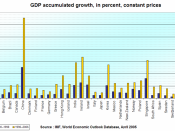Abstract
India is the second most populated country in the world with a forecasted GDP growth of 9% for 2006-07 which is second only to China. This has led to urbanization which is increasing at a steady pace. The growth in GDP has led to rising needs of high standard of living which has led to an increase in demand for power. India's power generation is today 15 to 20% below the requirements. This has resulted in low level of rural electrification and interrupted power supply to cities. The unreliability of power in India is the biggest hurdle for industrial development. In India power is primarily generated from thermal power plant which account for 59% of the total output. The fuel used in these power plants is coal which is a non-renewable resource and is depleting at a rapid pace. Hydro electricity has its own limitations as most of the rivers in India are not perennial.
Nuclear energy is an option available to India to meet the growing demand. The prospects and challenges of this power alternative is discussed in the following article.
1.1 Introduction
Power is a critical infrastructure on which the socio-economic development of the country depends. The growth of any economy hinges on the availability of reliable and quality power at competitive rates. The demand of power in India is enormous and is growing steadily.
India is endowed with a wealth of rich natural resources and sources of energy. However resources for power generation are unevenly dispersed across the country. This can be appropriately and optimally utilized to make available reliable supply of electricity. In India electricity required for the following sectors is as follows:
Generating capacity in India has increased from a meagre 1,362 MW in 1947 to above 85,744 MW in 1997. Electricity generation, which...


